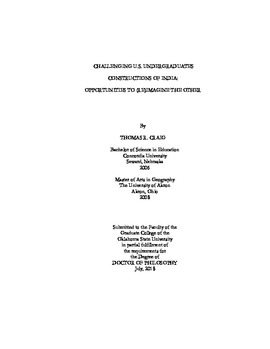| dc.description.abstract | Recently, the study of popular culture has expanded into its effect on students' perception of the "Other." Scholars argue that students use popular culture (e.g. news media, movies, television, internet, etc.) at all educational levels to understand and relate to academic material, particularly in geography. Therefore, popular culture is directly involved in the creation of what Edward Said coined "imaginative geographies," or collections of facts and stereotypes of places in the world. Although studies consider the imagined geographies of younger students (K-12), little research in geography explores undergraduates' imagined geographies. In this study, I use qualitative inquiry to examine the ways in which US undergraduates at three universities create, perpetuate, and challenge imagined geographies of India, especially via popular culture mediums. Using participant-driven photo-elicitation (PDPE) (including photographs, focus groups), I explore the ways in which students construct and may better nuance their perceptions and discussions centered on India. I use Said's theory of Orientalism as a lens for analysis. Additionally, through semi-structured interviews with thirty geography instructors across the United States, I explore how educators witness undergraduates' knowledge of distant places in class, and evaluate their varied attempts to complicate these imagined geographies. Overall, my findings indicate that students in higher education rely more on media and popular culture, rather than formal academic learning, although various types of personal relationships played an important role in the development of their perceptions of India. Also, students from different universities and at different points in their educational experience had noticeably different ways of describing India, and thus require unique approaches by instructors to effectively deconstruct their imagined geographies of place. Moreover, I argue for the usefulness of the PDPE approach as a means to help interrogate and nuance undergraduates' knowledge of the world. | |
